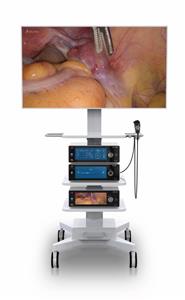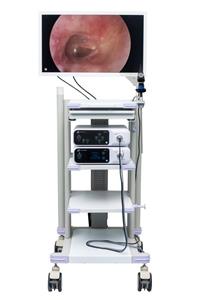Comparison of oncological outcomes of different laparoscopic surgical modalities for early cervical cancer
Patients with cervical cancer who underwent laparoscopic surgery in 6 medical centers in China from January 2011 to December 2014 were collected. , with regular follow-up data. They were divided into two groups according to different surgical methods, including modified transvaginal assisted laparoscopic surgery (modified laparoscopic group) and complete laparoscopic surgery (complete laparoscopic group). 5-year disease-free survival (DFS) and other oncological outcomes. Results A total of 674 patients with cervical cancer were included in this study, including 377 in the modified laparoscopy group and 297 in the complete laparoscopy group. (1) Comparison of 5-year OS between the two groups: the 5-year OS of patients in the modified laparoscopy group and the complete laparoscopy group were 96.1% and 92.0%, respectively, and the modified laparoscopy group was significantly higher than the complete laparoscopy group (P=0.010). The clinical stage (including Ib1, IIa1 stage), pathological type (squamous cell carcinoma, adenocarcinoma), and lymph node metastasis were further analyzed by stratification. The 5-year OS of patients with stage IIa1 was 93.6% and 77.6% in the modified laparoscopy group and the complete laparoscopy group, respectively, and the difference was statistically significant (P=0.012). There was also a statistically significant difference between the two groups (P=0.007). ②Pathological type: The 5-year OS of patients with squamous cell carcinoma in the modified laparoscopy group and the complete laparoscopy group were 96.1% and 92.3%, respectively, and the difference was statistically significant (P=0.046); the 5-year OS of patients with adenocarcinoma The ratios were 91.0% and 88.6%, respectively, and there was no significant difference between the two groups (P=0.230). ③ Lymph node metastasis: The 5-year OS of patients without lymph node metastasis in modified laparoscopy group and complete laparoscopy group were 98.6% and 96.4%, respectively, and the 5-year OS of patients with lymph node metastasis were 89.3% and 80.8%, respectively. The difference was not statistically significant (P=0.156, P=0.093). (2) Comparison of 5-year DFS between the two groups: The 5-year DFS of patients in the modified laparoscopy group and the complete laparoscopy group were 94.1% and 90.9%, respectively, and there was no significant difference between the two groups (P=0.220). Further stratified analysis of clinical stage, the results showed that the 5-year DFS of patients with stage Ib1, the modified laparoscopy group and the complete laparoscopy group were 97.0% and 92.8%, respectively, and the difference was statistically significant (P=0.039). ); the 5-year DFS of patients with stage IIa1 was 88.2% in the modified laparoscopy group and 75.8% in the complete laparoscopy group, and there was no significant difference between the two groups (P=0.074). Conclusion Different laparoscopic surgery methods can affect the oncological outcomes of patients with early-stage cervical cancer. The 5-year OS of patients with modified transvaginal assisted laparoscopic surgery is higher than that of patients with complete laparoscopic surgery, and the 5-year DFS of patients with stage Ⅰb1 is also higher than that of patients with complete laparoscopic surgery. Patients with complete laparoscopic surgery. It is suggested that the modified transvaginal laparoscopic surgery based on the principle of no tumor can still be used as the choice for the surgical treatment of early cervical cancer




